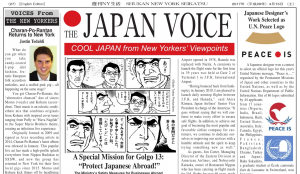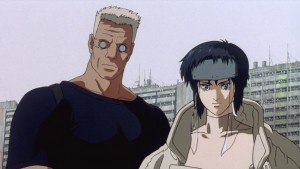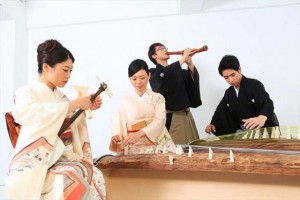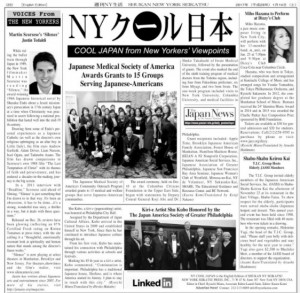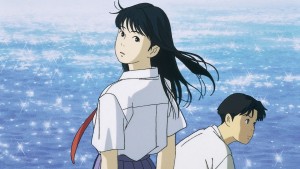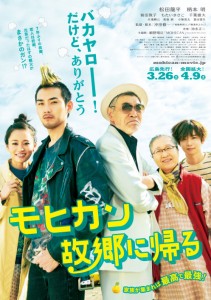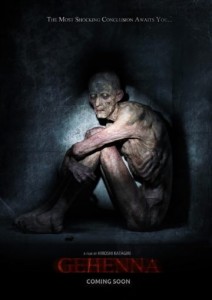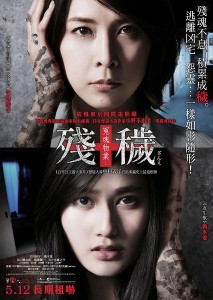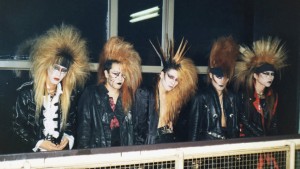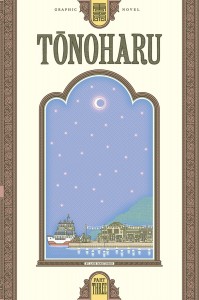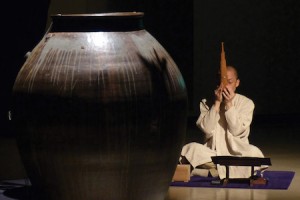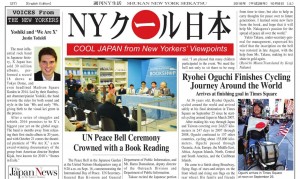WIT Life #312: The Departure
WIT Life is a periodic series written by professional Writer/Interpreter/Translator Stacy Smith (Kumamoto-ken CIR, 2000-03). She starts her day by watching Fujisankei’s newscast in Japanese, and here she shares some of the interesting tidbits and trends along with her own observations.
Last month’s Tribeca Film Festival featured the world premiere of the documentary The Departure directed by Lana Wilson. It profiles Ittetsu Nemoto, a Buddhist priest whose lifework is suicide prevention. In the group sessions he holds at his temple, he introduces exercises that attempt to show attendees what ending their lives would really mean in terms of loss and even simulates the experience of dying. Many participants come away with a renewed lease on life, and for those who don’t Nemoto makes himself available to them day and night whenever they need someone to talk to.
However, Nemoto’s devoted around-the-clock counseling takes its toll on him, both Read More
JQ Magazine: Nippon in New York — George Takei, Tokyo x Brooklyn, Japan Day @ Central Park
By JQ magazine editor Justin Tedaldi (CIR Kobe-shi, 2001-02). Justin has written about Japanese arts and entertainment for JETAA since 2005. For more of his articles, click here.
As spring continues and the weather continues to warm, New Yorkers can enjoy activities all over the city both indoors and out.
This month’s highlights include:
Monday, May 1, 7:30 p.m.
BAM Howard Gilman Opera House, 30 Lafayette Avenue
$35-$75
Actor and social justice activist George Takei brings his uncanny eloquence and signature wit to BAM. In this very special evening, he shares the story of his Japanese-American family’s forced internment during World War II, a seemingly forgotten part of American history. He also takes audiences through his rise to celebrity as a sci-fi icon, his remarkable journey as social media mega power, and his passionate fight for LGBTQ rights and marriage equality in America—empowering others to beat the odds and make a difference.

Courtesy of Asiasociety.org
Wednesday, May 3, 6:30 p.m.
Monkey Business: Japan/America Writers’ Dialogue
Asia Society, 725 Park Avenue
$20, $15 students/seniors, $12 members
Join a conversation between Japanese and American writers as part of the annual PEN World Voices Festival. This year’s featured writers are award-winning novelist Jamaica Kincaid, author Brian Evenson, Japanese writer Hiroko Oyamada, and Hiromi Ito, one of the most important female voices in contemporary Japanese poetry. Each ticket includes a complimentary copy of the latest volume (#7) of Monkey Business.
Thursday, May 4, 9:00 p.m.
Rough Trade NYC, 64 North 9th Street (Brooklyn)
$15
Kikagaku Moyo (Geometric Patterns) is the musical union between five free spirits. Go Kurosawa (drums, Vocals) and Tomo Katsurada (Guitar, Vocals) formed the band in 2012 as a free artist’s collective. They met Kotsuguy (Bass) while he was recording noise from vending machines and Akira (Guitar) through their university. Ryu Kurosawa had been studying Sitar in India, upon returning home he found the perfect outlet for his practice. Since 2013 the band has released two full lengths, an EP, and several singles. They have toured Australia, the United States, Europe and Japan extensively. Their music is a conversation—sometimes delicate and tender other times explosive, but always human and always changing. With support from Mountain Movers and Jason Spacin’ Killinger.
Thursday, May 11, 7:30 p.m.
B.B. King Blues Club & Grill, 237 West 42nd Street
$29.50-$69.50
With guitar styles ranging from rock, blues, jazz and fusion to pop and soul, Richie Kotzen has built a remarkably diverse 25-plus year career as a guitarist, singer and songwriter. A veteran of numerous groups including the Winery Dogs, Kotzen’s Japan cred is extensive: He wrote the number one song “Shine” as a member of Mr. Big, which was used as the ending theme for the anime series Hellsing, has recorded an entire album of music from the anime series Gundam, and toured as the opening act on the Japanese leg of the Rolling Stones’ 2006 tour. The Kotzen Telecaster guitar has repeatedly been the #1 selling signature model guitar for Fender Japan. This show will include selections from his new album, Salting Earth.
May 13-14
Brooklyn Expo Center, 72 Noble Street
$15-65
This all-new pop culture festival brings together two cultures, Tokyo and Brooklyn, featuring an exciting lineup of musicians, a variety of culinary favorites, innovative technology, artists and performers. The concept is to bridge the gap between Brooklyn creativity and craftsmanship and Japanese pop culture. Festival attendees experience more than just a spectacular neighborhood event, which Includes vintage anime screenings of films like Akira and Ghost in the Shell and headline performances from acts including MIYAVI, Anamanaguchi, DJ Logic (Plus Special Guests) and the Taiko Masala Thunder Drummers.
Sunday, May 14, 9:30 a.m.-4:00 p.m.
Free
Now in its eleventh year, Japan Day has won acclaim from New Yorkers from every walk of life, with Mayor Michael de Blasio calling it an eagerly anticipated cultural event on the city’s calendar. For this year’s event, organizers are planning once again to have both the Japan Run (beginning in the early morning) and the Japan Day Festival, emphasizing enjoyable activities for all ages that will deepen participants’ understanding and appreciation of Japanese culture—not to mention the food, drinks and snacks! Hosted by CNN national correspondent Sandra Endo, previous guest performers have included AKB48, Jero and Akiko Yano.
Sunday, May 28, 5:00 p.m.
Irving Plaza, 17 Irving Place
$25 GA, $95 VIP meet and greet
Generations from Exile Tribe (a.k.a. Generations) is a seven-member Japanese boy band signed to the Avex Group label Rhythm Zone. lThe group belongs to the talent agency LDH and is part of the collective “Exile Tribe,” related to pop group Exile. Generations debuted in November 2012 and is ready to make its New York debut.
Want to stay in the loop on future events? Follow Justin on Facebook and Twitter.
Justin’s Japan: Charan-Po-Rantan Returns to New York
By JQ magazine editor Justin Tedaldi (CIR Kobe-shi, 2001-02) for Shukan NY Seikatsu. Justin has written about Japanese arts and entertainment for JETAA since 2005. For more of his articles, click here.
What do you get when you take candy-coated J-pop idol fashion, frenetic European folk accordion melodies, and a stuffed pink pig—all happening on the same stage?
You get Charan-Po-Rantan, the “alternative chanson” duo of sisters Momo (vocals) and Koharu (accordion). Their music is an eclectic, multi-ethnic mix that combines originals from Koharu with inspired cover tunes ranging from Puffy to “Hava Nagilah” to the Super Mario Brothers theme, creating an infectious live experience.
Originally formed in 2009 and signed as Avex recording artists in 2014, Charan-Po-Rantan’s latest album was released in January. This popular live act has made a high-profile splash everywhere from Nippon Budokan to SXSW, and now the group has returned to New York for their first local gigs since 2015. Momo and Koharu kick things off by headlining Joe’s Pub on April 24, followed by an encore performance at Japan Society as part of the Godzilla Legend: Music of Akira Ifukube showcase with techno-pop band Hikashu on April 28.
In a statement about the upcoming shows, the group said, “We are so happy to be going back to our favorite place—New York! We heard that New York is called a salad bowl of different cultures, and our music is sometimes called ‘a melting pot of world music.’ Please come taste our Tokyo sound, which mixes different genres and eras.”
For more information and tickets, follow the group on Facebook at /charanporantan.
JQ Magazine: Nippon in New York — ‘Your Name,’ Miyavi, Charan-Po-Rantan
By JQ magazine editor Justin Tedaldi (CIR Kobe–shi, 2001-02) for Examiner.com. Visit his Japanese culture page here for related stories.
Spring has sprung in the Big Apple, and that means one thing: a new season of sounds, colors, and spectacular performing arts to match the blossoming sakura trees throughout the city.
This month’s highlights include:
Now playing
Landmark Sunshine Cinema, 143 East Houston Street
$14.50
Written and directed by Makoto Shinkai (5 Centimeters Per Second, Children Who Chase Lost Voices), the highest-grossing internationally released anime film in history finally comes to America! The day the stars fell, two lives changed forever. High schoolers Mitsuha and Taki are complete strangers living separate lives. But one night, they suddenly switch places. Mitsuha wakes up in Taki’s body, and he in hers. This bizarre occurrence continues to happen randomly, and the two must adjust their lives around each other. Yet, somehow, it works. They build a connection and communicate by leaving notes, messages, and more importantly, an imprint. When a dazzling comet lights up the night’s sky, something shifts, and they seek each other out wanting something more—a chance to finally meet.
Sunday, April 9, 8:00 p.m.
B.B. King Blues Club and Grill, 237 West 42nd Street
$29.50 advance, $35 day of show
A courageous, spiritually-driven and consummate artist who transcends boundaries, Keiko Matsui has worked alongside the best, including Miles Davis, Stevie Wonder, Hugh Masakela, and Bob James. Her unique melting pot of musical influences have garnered her a devout international following, as she tours relentlessly and seeks to make a genuine connection with her audience. “This music energizes me and I am overwhelmed with emotion when I listen to it. I hope people will allow themselves to go inside the music and become a part of my journey,” says the Tokyo native. In the words of Duke Ellington, Keiko Matsui is “beyond category.”
Friday, April 21, 7:30 p.m. and 9:30 p.m.
Club Bonafide, 212 East 52nd Street
$20
Orange Pekoe is a band composed of vocalist Tomoko Nagashima and guitarist Kazuma Fujimoto. Formed in 1998, they started creating original songs and have developed a unique sound sublimating various types of music such as jazz, Latin, Brazilian and soul. Since then, Orange Pekoe has been acclaimed as a one-of-a-kind uniquely artistic band.. Their performance style varies from a duo to a band, sometimes playing alongside a 16-member big band-style orchestra, which they received renown as one of the most unique and talented artists in Japan.
JQ Magazine: Film Review — ‘Your Name’

“You do not have to like animated or Japanese films specifically to love Your Name. However, it is rare for any film to capture the Japanese essence and tone as this one has so expertly achieved.” (© 2016 “YOUR NAME.” FILM PARTNERS)
By Greg Beck (Hiroshima-ken, 2006-11) for JQ magazine. Greg is a writer, producer, home brewer, and Social Coordinator for JETAA Southern California and Arizona. A former news producer for Tokyo Broadcasting System in New York, he currently works freelance in Los Angeles. For more cinema reviews, follow him on Twitter at @CIRBECK #MovieReview.
Never mind that Your Name has become the highest-grossing Japanese film internationally, anime or otherwise; this creative and beautiful film written and directed by Makoto Shinkai (5 Centimeters Per Second, Children Who Chase Lost Voices) draws on everything reverent in Japanese history and culture, celebrates the modern metropolis that is Tokyo, and tugs at your heartstrings while embracing the silly and universally relatable challenges of the human experience. You do not have to like animated or Japanese films specifically to love Your Name. However, it is rare for any film to capture the Japanese essence and tone as this one has so expertly achieved.
The story focuses on Mitsuha Miyamizu, a high school girl living in a tiny, rural village in the Hida region of Gifu—or as one classmate puts it: “the boonies.” Growing up with her little sister and grandmother at the local shrine, we are introduced to a culturally rich history of weavers who connect their trade to the local Shinto god and traditions. Mitsuha feels understandably cramped by her rural routine and dreams of moving to Tokyo. Suddenly, that is just where she finds herself, inexplicably waking up in the body of our second protagonist, Taki, a boy of the same age, living in a small apartment with his father in Shinjuku.
As the story progresses, we get to enjoy both very different worlds, but there is no denying the village’s gorgeous rural landscapes rich with nature and the intimate, cultural ceremonies that take center stage. The grandmother’s patient lessons on Mitsuha’s family history grant us special access to something sacred, like a backstage pass to Japanese culture. The last film to achieve this feeling, Okuribito (Departures), later won the Oscar for Best Foreign Language Film in 2009. Your Name is similar, but surpasses it by making the cord weaving pivotal to understanding the supernatural body swapping, blending epic adventure with sublime heartache.
Justin’s Japan: ‘Your Name’ Premieres at NYICFF
By JQ magazine editor Justin Tedaldi (CIR Kobe-shi, 2001-02) for Shukan NY Seikatsu. Justin has written about Japanese arts and entertainment for JETAA since 2005. For more of his articles, click here.
Now celebrating its 20th year, the New York International Children’s Film Festival returns this month, continuing its mission to cultivate an appreciation for the arts for moviegoers of all ages.
Anime films are a staple of NYICFF, and this year’s citywide selections are “Rudolf the Black Cat” (Feb. 25, March 4-5, 19), a modern-day CGI-animated tale of two kitties that celebrates the wonder of discovery; “Panda! Go Panda!” (Feb. 26, March 5, 11, 18), a retro classic from 1972 directed by Isao Takahata and featuring original concepts and character designs by Hayao Miyazaki; and “Ancien and the Magic Tablet” (March 18-19), a fender- and genre-bending film set in the not-too-distant future whose second screening also hosts director Kenji Kamiyama as part of the closing ceremonies.
By far, the most anticipated film is the East Coast premiere of “Your Name” (Feb. 25). Released in Japan last August, it smashed all box office records for the year and is currently the highest-grossing anime film worldwide (beating out Miyazaki’s own Oscar-winning “Spirited Away” by over $40 million at press time).
Written and directed by Makoto Shinkai (“5 Centimeters per Second”), “Your Name” tells the story of a young man living in Tokyo and a young woman living in the countryside who suddenly start switching bodies on a regular basis. It has been widely praised for both its animation style and emotional impact.
For more on this year’s festival, visit http://nyicff.org. Tickets are available at www.ticketweb.com.
JQ Magazine: Nippon in New York — ‘Your Name’ Premiere, Hougaku Quartet, ‘Girl X’
By JQ magazine editor Justin Tedaldi (CIR Kobe-shi, 2001-02). Justin has written about Japanese arts and entertainment for JETAA since 2005. For more of his articles, click here.
Stay warm this winter with some hot local events, from an exhibition that will transport you to another time and place, some new an classic anime screenings, and a mash-up multimedia performance you won’t want to miss.
This month’s highlights include:
Now through May 14
Children’s Museum of Manhattan, 212 West 83rd Street
$12 children and adults, $8 seniors
Back for the new year, this exhibit highlights how old and new traditions coexist in Japan, giving visitors a family-friendly window into Japanese culture. Children will have fun learning about life in present day Japan in this playful, immersive environment. Hello from Japan! is a new interactive exhibit in the Museum’s Lower Level Gallery. It will transport families to two distinct areas of Tokyo that exist side by side: the serene and exquisite Shinto Shrine Park, and the too-cute-for-words Kawaii Central.
Feb 7-8
City Cinemas Village East Cinema, 181-189 Second Avenue
$15
Before the release of next month’s live-action adaptation starring Scarlett Johansson and Takeshi Kitano, catch one of the greatest anime films of all time (based on the manga by Masamune Shirow and directed by Mamoru Oshii) on the big screen! In the near future, an elite group of police cyborgs called Section 9 works to stop hackers from commiting cyber crimes across the globe. However, there skills are put to the test when they come up against a hacker known as the Puppet Master. The pair of Feb. 7 screenings will be in Japanese with English subtitles; Feb. 8’s screening is English dubbed.
Thursday, Feb. 16, 8:00 p.m.
Asia Society, 725 Park Avenue
Free, tickets available here.
Re-envisioning Japanese traditional instruments for contemporary music, the Hougaku Quartet explores everything from traditional Japanese music to cutting edge new compositions, all performed on traditional instruments. The quartet is made up of a group of young virtuoso musicians who graduated from Tokyo University, who have mastered the art of creating music for today and for the future, through traditional Japanese instruments. The Hougaku Quartet carries out its mission through commission, revival performance of masterpieces composed after the 1960s, and performance in the traditional “Sankyoku” ensemble style. A group of young musicians who are committed to both sustaining and expanding tradition, Hougaku Quartet is a fresh approach to Japanese music. With a special guest performance by Ralph Samuelson.
By JQ magazine editor Justin Tedaldi (CIR Kobe-shi, 2001-02) for Shukan NY Seikatsu. Justin has written about Japanese arts and entertainment for JETAA since 2005. For more of his articles, click here.
While riding the bullet train through Japan in 1989, the New York filmmaker Martin Scorsese was reading “Silence,” the award-winning 1966 Japanese historical novel by Shusaku Endo abut a Jesuit missionary’s persecution in 17th century Japan at a time when Christianity was practiced in secret following a national prohibition that lasted well into the mid-19th century.
Drawing from some of Endo’s personal experiences as a Japanese Catholic (as well as the director’s own religious upbringing as an altar boy in Little Italy), the film stars Andrew Garfield, Adam Driver, Liam Neeson, Issei Ogata, and Tadanobu Asano. The film has drawn comparisons to Scorsese’s own 1988 film “The Last Temptation of Christ” with its themes of faith and perseverance, and has endured a decades-in-the-making journey to the big screen.
In a 2011 interview with “Deadline,” Scorsese said ahead of filming, “‘Silence’ is just something that I’m drawn to in that way. It’s been an obsession, it has to be done…it’s a strong, wonderful true story, a thriller in a way, but it deals with those questions.”
Released on Dec. 26, reviews have been glowing (reflecting an 87% Certified Fresh rating on Rotten Tomatoes at press time), with the site calling it a “thoughtful, emotionally resonant look at spirituality and human nature that stands among the director’s finest works.”
“Silence” is now playing at select theaters in Manhattan, Brooklyn and New Jersey. For more information, visit www.silencemovie.com.
JQ Magazine: Nippon in New York — Anime films, Final Fantasy Live, Yoshiki at Carnegie Hall
By JQ magazine editor Justin Tedaldi (CIR Kobe-shi, 2001-02). Justin has written about Japanese arts and entertainment for JETAA since 2005. For more of his articles, click here.
Start 2017 off right by heading down to your local concert hall, cinema, or arts center for some fantastic new year’s fare. Whether you enjoy movies, travel, or orchestral performances classic video games, treat yourself and catch a break from the cold.
This month’s highlights include:
Now playing through Jan. 5
IFC Center, 323 Sixth Avenue
$15
New 4K restoration! Rarely seen outside of Japan, Ocean Waves is a subtle, poignant and wonderfully detailed story of adolescence and teenage isolation. Taku and his best friend Yutaka are headed back to school for what looks like another uneventful year. But they soon find their friendship tested by the arrival of Rikako, a beautiful new transfer student from Tokyo whose attitude vacillates wildly from flirty and flippant to melancholic. When Taku joins Rikako on a trip to Tokyo, the school erupts with rumors, and the three friends are forced to come to terms with their changing relationships. As the first Studio Ghibli film directed by someone other than studio founders Hayao Miyazaki and Isao Takahata, these new screenings of Ocean Waves are paired with Ghiblies: Episode 2, a unique 25-minute short film from Studio Ghibli, featuring several comedic vignettes of studio staff as they go about their day. Utilizing new animation techniques and software that would then be deployed on the production of My Neighbors the Yamadas, Ghiblies: Episode 2 made its North American debut in December 2016. Presented in Japanese with English subtitles.
January 5 & 9, 7:00 p.m.
Princess Mononoke: 20th Anniversary
AMC Empire 25, 234 West 42nd Street
$15.99
A two-night event! Princess Mononoke, the classic animated film from groundbreaking writer/director Hayao Miyazaki and the legendary Studio Ghibli, returns to movie theaters in celebration of the beloved historical fantasy’s 20th anniversary and director Miyazaki’s birthday. The first Studio Ghibli film to receive an uncut U.S. theatrical release, Princess Mononoke returns to cinemas subtitled on Jan. 5 at 7:00 p.m. and English-dubbed on Jan. 9 at 7:00 p.m. The celebration will include a special bonus screening of the music video directed by Hayao Miyazaki, Chage and Aska’s “On Your Mark”!
Jan. 5-9
The Public: Martinson Hall, 425 Lafayette Street
$25, $20 members
Part of the 2017 Under the Radar Festival! Tokyo, 1937: An American silent film about a Japanese immigrant is introduced by a celebrated narrator whose existence is being threatened by the impending arrival of the talkies. Ten years later, he will survive under U.S. occupation as a street performer, desperately attempting to finish this story. Admiration and resistance, dreams and survival, Club Diamond is a modern take on the immigration tale. Its creators are Nikki Appino, an award-winning filmmaker, Saori Tsukada, who has been described as a “charismatic mover” (Backstage) and a “startlingly precise dancer” (The New York Times), and has been developed in collaboration with violinist Tim Fain.
WIT Life #308: Silence
WIT Life is a periodic series written by professional Writer/Interpreter/Translator Stacy Smith (Kumamoto-ken CIR, 2000-03). She starts her day by watching Fujisankei’s newscast in Japanese, and here she shares some of the interesting tidbits and trends along with her own observations.
Last night I attended a screening of Martin Scorsese’s new film Silence, based on the 1966 novel 沈黙 (Chinmoku) by Shusaku Endo, himself a Japanese Catholic. It is the story of a Jesuit missionary sent to 17th century Japan, who is playe d with great nuance by Andrew Garfield. He and his followers endure horrible persecution during this period when 隠れキリシタン (Kakure Kirishitan or Hidden Christians) are targeted for their beliefs. Having lived in Kyushu I had a vague sense of what had taken place in Nagasaki at that time, but not the extent of the barbaric ways Christians were killed and tortured. Read More
d with great nuance by Andrew Garfield. He and his followers endure horrible persecution during this period when 隠れキリシタン (Kakure Kirishitan or Hidden Christians) are targeted for their beliefs. Having lived in Kyushu I had a vague sense of what had taken place in Nagasaki at that time, but not the extent of the barbaric ways Christians were killed and tortured. Read More
By David Reilling (Nagano ALT), writing from Sydney, Australia.
The Mohican Comes Home or “Mohican kokyô ni kaeru” tells the story of an estranged son returning to his hometown after being gone for a long time. This is a common theme in several other films such as the Godfather, literature and even the Bible, i.e. the Parable of the Prodigal Son. The humour and touching moments in individual scenes make this movie enjoyable to watch despite the predictable plot.
Eikichi Tamura left Hiroshima for Tokyo, hoping to become famous with his band. Like countless other would-be stars before him, Eikichi’s dream never takes off in the big city. The movie opens with Eikichi, the lead singer in a metal band, screaming “Get Sick and Die” to a bloodthirsty crowd of heavy metal fans smashed into a basement bar. The next scene cuts to Eikichi and his bandmates sitting backstage, looking tired and sombre. One of the members confesses: “I get more of a kick out of doing my part-time job.” This scene shows a glimpse into the outcast world of freeters, Japanese people who deliberately choose not to become salary-men and find work in non-traditional areas.
Eikichi goes home to his girlfriend and cramped apartment; he then decides to return home in order to tell his father, Osamu, that his girlfriend is pregnant.
The movie jumps to an unnamed island in Hiroshima and introduces Eikichi’s father. Osamu is a foil to Eikichi. Eikichi has a mohawk-haircut and screams obscenities at a crowd of mosh-pitters. Osamu is in all white suit, attempting to mimic 1980s pop rocker Eikichi Yazawa, and directing a school band of ten unenthusiastic junior high students playing at a temple for an audience of elderly townsfolk. Anyone who has ever taught English in a rural Japanese town will find this scene hilarious. Afterwards, Osamu berates the students for the awful performance as they stare at the ground.
He strikes a pose, again mimicking his idol Yazawa, and offers advice “Life… is a constant battle with yourself. OK?” Funny Scenes like this make the otherwise dull plot bearable.
From this point on the plot becomes predictable. Coincidentally immediately after Eikichi returns home, Osamu is diagnosed with cancer. The plot then follows a standard curve of a father and son trying to repair their relationship. Again, despite the lame plot, several scenes in the movie achieve a fantastic balance between touching and humorous.
In one scene, Osamu wants to eat a specific sausage pizza he had for his birthday some 20 years ago. In order to give his father satisfaction, Eikichi orders all of the sausage pizzas he can find from the mainland.
Eikichi strives to give his father closure. In my opinion, the peak of the movie is when Eikichi pretends to be his father’s idol, Eikichi Yazawa. Osamu states earlier in the movie that “Yazawa is his only pleasure in life” and that he named Eikichi after Yazawa. By this point in the movie, Osamu’s illness has degraded his memory. He cannot tell that the man in the white suit claiming to be Yazawa is really his son.
Osamu breaks down and confesses the high point in his life: meeting Yazawa’s eyes across the crowd at a concert in 1977. Could this really be the high point of someone’s life? Eikichi is remarkably patient with his father, considering his dad ranks a pop star ahead of his family.
The movie’s supporting cast, Eikichi’s mom, brother and girlfriend, played by the former all-girl band AKB48 lead singer, Maeda Atsuko, do an OK job. If the supporting cast are wheels, Eikichi and Osamu are the engine which drive the movie until the end. I seriously question why director Shuichi Oita chose to cast well-known, wealthy and successful actors to play the parts of freeters and country folk. The roles seemed fitting for lesser known actors or real live freeters to get their chance in the film industry.
Without revealing too much, I found the ending to be a disappointment. The conclusion felt hurried and lacked the impact of the rest of the movie. Does the poor story and mediocre ending make this a bad movie? Actually no. If viewed as separate short stories, the scenes are moving and hilarious vignettes. The ‘Mohican Comes Home’ will make anyone who has ever lived in the Japanese countryside long to return.
The Mohican Come Home (Mohican kokyô ni kaeru) by Shuichi Okita, released March 13 2016 in Japan, starring Ryuhei Matsuda, Akira Emoto, Atsuko Maeda, Masako Motai, Yudai Chiba, Katsumi Kiba, Jun Miho, Ryouta Koshiba, Miu Tomita.
Q&A with Director Hiroshi Katagiri (“GEHENNA: Where Death Lives”)
By David Reilling (Nagano, ALT) and Eden Law (Fukushima, ALT). David hails from Cleveland, Ohio, and now lives on the Central Coast, Sydney in Australia. Eden is also from Sydney (via Malaysia). The interview questions were done by David, while Eden is the editor and did the write-up for this article.
Here in Sydney we do love our film festivals, ranging from the grand Sydney Film Festival, to numerous language, cultural or country-based film programmes like the Japanese Film Festival (also grand), documentaries (Antenna) and short films (Tropfest). Horror and sci-fi gets to shine at the combined ‘A Night of Horror’ and ‘Fantastic Planet’ festival. This is also where director Hiroshi Katagiri gets to shine, with his debut film ‘GEHENNA: Where Death Lives’, after working in the industry as a special effects and makeup artist, sculptor and creature-creator (his impressive IMDB page lists some well-known entries like Wolverine, Hunger Games, Pirates of the Caribbean, Looper). He also lists his favourite films in the genre as ‘Zathura’ and ‘Cabin in the Woods’, giving you an idea of the influences in his film.
‘GEHENNA’ follows five people scouting for locations to build a spanking brand new resort, and while on a secluded island paradise, stumble across an abandoned Japanese WWII bunker, and decides to go exploring. As you can imagine, this is a Really Bad Idea – check out the trailer below.
We had a quick correspondence with Hiroshi as part of the promotion for film.
Your bio says you “moved to the US at age 18 to pursue a career in special makeup effects.” How did you start a career in special effects?
Basically I had build my portfolio and use that to approach make-up FX studios. That was in 1991 and it was kind of a new industry and… work and entry level [positions] were very low. I still feel I was so fortunate.
What was the most difficult special effects thing you ever made?
Dead mermaids for ‘Pirates of the Caribbean on Stranger Tide.’ Not technically difficult but I only had 7 weeks from start to finish to build 3 full body silicon mermaids. That was insane.
You directed the movie Gehenna: Where Death Lives. You also wrote it and did the special make-up effects. How was it? How long did it take? Tell us about it.
For the writing, I was writing as I’m thinking, “How do I make this?”. Since I know what exactly I can do, that really helped on writing… Doing make up FX myself is the best way to save money and keep quality. If I hire someone for this quality of FX, it will cost. It is not easy but I needed to do it. If there’s enough budget, I wouldn’t do the FX myself. I started doing make-up FX about 5 months before start of filming.
Why did you choose Saipan [location of the film]?
I was looking to the location where Japan and America fought. Saipan just came up to my mind first.
What challenges did you have filming there?
Biggest challenge was the weather. We avoided the rainy season but there were rainstorms. On first day of shoot, we had 5-6 showers between. That was scary. I had to modify camera angles to hide wet ground.
Will you direct a movie again?
Of course I will!
Will you make a movie in Australia?
Sure I’d love to! I’m a huge fan of Mad Max!!
“Inerasable” – Film Review from the 20th JFF (Australia)
David Reilling lived in Nagano Prefecture, Japan for five years as an ALT. Although he is originally from Cleveland, Ohio in the United States, he is now living on the Central Coast of Australia. He loves traveling and could be anywhere next.
‘The Inerasable’ or “Zan’e: Sunde wa ikenai heya” frightens the viewer and draws them into plot from the start.
The scene jumps to the present. The main character, played by Yuko Takeuchi, is an unnamed author of mystery-novels. Yuko’s character is currently attempting to write a horror novel with the help of her writers’ group. She receives a letter from a university student living in Tokyo, Futa, asking for her help. Futa believes a restless spirit haunts her apartment.
The best scenes of the movie happen in this early half of the movie. Futa sits down at her kitchen table in the evening to do homework and hears a sweeping noise behind her. She spins around and peers into her bedroom. She sees nothing and returns to her homework. The sweeping noise persists. The music stops. She tiptoes over to her bed, and looks underneath it. She finds nothing, yet the sweeping continues.
The scene was terrifying due to the plausibility: What would you do if you kept hearing the same strange noise in your apartment? I would probably call the Ghost Busters and Bill Murray.
These early scenes set a high standard. I expected to be jumping out of my IKEA couch for the rest of the movie. As Yuko Takeuchi’s character and Futa begin exchanging letters a deeper mystery begins to unravel. Other residents of the apartment building have been experiencing strange occurrences too. The previous resident of Futa’s apartment number only lasted 6 months. The young father of a family moving next door approaches Futa. He pulls her aside and asks, “Did anything strange happen here? The rent is lower than this general area.” I immediately paused the movie and compared the rent of my apartment against data on realestate.com.au. I breathed a sigh of relief: it is 10% above the average rent cost.
The novelist and Futa look further into the history of the apartment building and its former occupants. Unfortunately, the plot descends into absurdity when attempting to link the current state of the apartment building to a long series of bizarre past tragedies. The previous occupant of Futa’s apartment hung himself in his new apartment after going mad from hearing the same sweeping noises. The noises appear be the brushing of a kimono along the floor after a woman hung herself and swayed from the rafters.
‘Inerasable’ leaves the horror genre and becomes a mystery. The apartment building sits on cursed ground. Before the apartments were built, a crazy old man who hoarded bags of trash inside his house, suffocated to death.
The main characters dig deeper into the histories of previous homeowners on the lot. Nearly 50 years earlier, a woman and her husband return home after attending their daughter’s wedding. The husband sits down to enjoy a cup of sake. Without a word, the woman hangs herself from the rafters, her kimono sash swishing along the floor. Has the source of the supernatural evil just been uncovered?
The plot becomes overly complicated at this point, deviating from the suspense of the first half. The two detectives pursue a bizarre chain of events so disturbing they become implausible and outrageous. As it turns out, a mother turned baby killer also lived on the land. Before her, another family imprisoned their mentally ill son in a cage. Somewhere in-between these two stories, a legend of a cursed portrait of a woman is told by a Buddhist monk. Is the picture the true source of the supernatural evil?
Not quite. In yet another turn of the plot, the picture originally came from a family in Kyushu, the Okuyama family. Of course something tragic happened to this family too. The husband was driven mad by voices, killed his entire family with a katana and then took his own life with the sword. Surely this is the last piece, right?
Wrong again. It turns out the crazy husband was the boss of a coal mine where over 100 miners died in an accident. The miners cursed the coal boss and agreed to haunt his house, pushing him into madness.
If the plot wasn’t bizarre enough, Yuko’s Takeuchi’s character suddenly appears wearing a neck brace for no reason connected to the plot.
The mystery ends because both Futa and the writer give up. Futa admits defeat: “The curse just keeps going. I’m at the point where I’m no longer sure what I’m looking for.” As a viewer, I was no longer sure what I was supposed to be looking for in this movie. ‘The Inerasable’ began as an excellent horror movie then devolved into a tangled and far-fetched mystery movie. I wanted the movie to stick with the simple and suspenseful formula from the first half.
On a final note, The latter half of the movie did have some interesting scenes showing jichinsai, a traditional Shinto ground-breaking ceremony. A temporary shrine is built and a Shinto priest in traditional garb blesses the ground before construction begins. The ceremony still occurs today.
The Inerasable (Zan’e: Sunde wa ikenai heya) by Yoshihiro Nakamura, released October 25 2015 in Japan, starring Takeuchi Yuko, Hashimoto Ai, Sasaki Kuranosuke, Sakaguchi Kentaro, Takito Kenichi.
JQ Magazine: Nippon in New York — ‘We Are X,’ ‘Tonoharu,’ VAMPS, Momoiro Clover Z
By JQ magazine editor Justin Tedaldi (CIR Kobe-shi, 2001-02). Justin has written about Japanese arts and entertainment for JETAA since 2005. For more of his articles, click here.
From the silver screen to the stage to J-pop, November is just as colorful as the autumn leaves drifting through the air. Add these live events to the mix and you’ve got an irresistibly epic rundown.
This month’s highlights include:
Friday, Nov. 4, various times
Alamo Drafthouse Downtown Brooklyn, 445 Albee Square West
$11
East Coast premiere! This award-winning documentary debuted at Sundance and SXSW earlier this year chronicles the back story of the hard rock band X Japan, as its star drummer Yoshiki prepares for a reunion concert at Madison Square Garden. While virtually unknown to U.S. audiences, Yoshiki has sold more than 30 million records overseas, where he enjoys an A-list following. Directed by Stephen Kijak (Stones in Exile) and produced by John Battsek (Searching for Sugar Man), We Are X includes testimonials from such high-profile X fans as Gene Simmons and Marilyn Manson. See Yoshiki and director Stephen Kijak in person for Q&A on Fri, 11/4 following the 7:30 p.m. show. Director Stephen Kijak appears in person for Q&A Sat, 11/5 following the 6:30 p.m. show.
Tuesday, Nov. 8
$24.95
The long-awaited final volume of the critically acclaimed Tonoharu series from JET alum Lars Martinson (Fukuoka-ken, 2003-2006) rejoins Dan Wells several months into his tenure as an English teacher in the Japanese village of Tonoharu. As personal stresses push Dan to the breaking point, he decides to take an extended cross-country vacation to let off steam. His time away grants him a fresh perspective on his troubles, but upon his return to Tonoharu, Dan discovers that dramatic change has occurred in his absence. Will this upheaval render his new-found epiphany moot? With hundreds of beautiful, detailed illustrations that evoke 19th century line engravings, Tonoharu provides a nuanced portrayal of the joys and frustrations of living abroad.
Friday, Nov. 11, 8:30 p.m.
Sounds to Summon the Japanese Gods: Ko Ishikawa
Japan Society, 333 East 47th Street
$20, $15 Japan Society members. A limited number of Lobby Seats are available for purchase. Please call the box office at (212) 715-1258 to inquire.
Step into a space where otherworldly sounds abound. Led by Ko Ishikawa, master player of the sho (ancient Japanese mouth organ) and internationally active contemporary musician, this program offers selections spanning from medieval gagaku (Imperial Court music) to works by acclaimed music composer Mamoru Fujieda. Ishikawa will be joined by Kayoko Nakagawa on koto and Ami Yamasaki on voice for this musical soiree, which also incorporates the sounds of fermenting shochu (Japan’s distilled alcohol), a highly sacred beverage in Japanese mythology.
Justin’s Japan: Yoshiki and ‘We Are X’
By JQ magazine editor Justin Tedaldi (CIR Kobe-shi, 2001-02) for Shukan NY Seikatsu. Justin has written about Japanese arts and entertainment for JETAA since 2005. For more of his articles, click here.
The most influential rock band in Japanese history, X Japan has sold 30 million albums, performed a record 18 shows at Tokyo Dome, and even headlined Madison Square Garden in 2014. Led by their flamboyant drummer/pianist Yoshiki, the band rewrote the rules for both sound and style in the late ’80s and early ’90s, giving birth to the visual kei genre in the process.
After a series of struggles and rebirth, 2016 promises to be X’s biggest year yet on the global stage. The band is months away from releasing their first studio album in 20 years, and with October 21 comes the theatrical premiere of “We Are X,” a new award-winning documentary of the group from American director Stephen Kijak, best known for 2010’s “Stones in Exile.”
The film had its first-ever screening at Sundance in January, and Yoshiki himself appeared in New York last month for a special invitation-only screening of the film at the Crosby Street Hotel in Soho, where he participated in a Q&A with the director, played grand piano, and greeted some very lucky fans.
While X Japan has no current plans to tour America, fans hoping to see Yoshiki on stage won’t have to wait too long: Yoshiki Classical with the Tokyo Philharmonic Orchestra makes its Carnegie Hall debut January 12 and 13. Tickets are available now. For more information on cities and premiere dates for the film, visit www.wearexfilm.com.
Justin has written about Japanese arts and entertainment since 2005. For more of his stories, visit http://jetaany.org/magazine.







